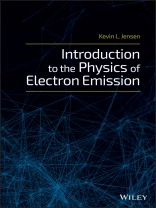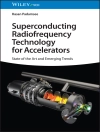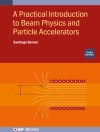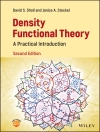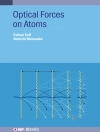A practical, in-depth description of the physics behind electron emission physics and its usage in science and technology
Electron emission is both a fundamental phenomenon and an enabling component that lies at the very heart of modern science and technology. Written by a recognized authority in the field, with expertise in both electron emission physics and electron beam physics, An Introduction to Electron Emission provides an in-depth look at the physics behind thermal, field, photo, and secondary electron emission mechanisms, how that physics affects the beams that result through space charge and emittance growth, and explores the physics behind their utilization in an array of applications.
The book addresses mathematical and numerical methods underlying electron emission, describing where the equations originated, how they are related, and how they may be correctly used to model actual sources for devices using electron beams. Writing for the beam physics and solid state communities, the author explores applications of electron emission methodology to solid state, statistical, and quantum mechanical ideas and concepts related to simulations of electron beams to condensed matter, solid state and fabrication communities.
- Provides an extensive description of the physics behind four electron emission mechanisms—field, photo, and secondary, and how that physics relates to factors such as space charge and emittance that affect electron beams.
- Introduces readers to mathematical and numerical methods, their origins, and how they may be correctly used to model actual sources for devices using electron beams
- Demonstrates applications of electron methodology as well as quantum mechanical concepts related to simulations of electron beams to solid state design and manufacture
- Designed to function as both a graduate-level text and a reference for research professionals
Introduction to the Physics of Electron Emission is a valuable learning tool for postgraduates studying quantum mechanics, statistical mechanics, solid state physics, electron transport, and beam physics. It is also an indispensable resource for academic researchers and professionals who use electron sources, model electron emission, develop cathode technologies, or utilize electron beams.
Mục lục
Acknowledgements xiii
Part I: Foundations
1 Prelude 3
2 Units and evaluation 7
2.1 Numerical accuracy 7
2.2 Atomic-sized units 8
2.3 Units based on emission 11
3 Pre-quantum models 13
3.1 Discovery of electron emission 13
3.2 The Drude model and Maxwell–Boltzmann statistics 13
3.3 The challenge of photoemission 19
4 Statistics 25
4.1 Distinguishable particles 25
4.2 Probability and states 28
4.3 Probability and entropy 30
4.4 Combinatorics and products of probability 33
5 Maxwell–Boltzmann distribution 37
5.1 Classical phase space 37
5.2 Most probable distribution 39
5.3 Energy and entropy 41
5.4 The Gibbs paradox 42
5.5 Ideal Gas in a potential gradient 44
5.6 The grand partition function 45
5.7 A nascent model of electron emission 46
6 Quantum distributions 49
6.1 Bose–Einstein distribution 49
6.2 Fermi–Dirac distribution 50
6.3 The Riemann zeta function 50
6.4 Chemical potential 52
6.5 Classical to quantum statistics 56
6.6 Electrons and white dwarf stars 57
7 A box of electrons 61
7.1 Scattering 61
7.2 From classical to quantum mechanics 61
7.3 Moments and distributions 63
7.4 Boltzmann’s transport equation 64
8 Quantum mechanics methods 73
8.1 A simple model: the prisoner’s dilemma 73
8.2 Matrices and wave functions 78
9 Quintessential problems 91
9.1 The hydrogen atom 92
9.2 Transport past barriers 102
9.3 The harmonic oscillator 110
Part II: The canonical equations
10 A brief history 121
10.1 Thermal emission 121
10.2 Field emission 122
10.3 Photoemission 123
10.4 Secondary emission 124
10.5 Space-charge limited emission 124
10.6 Resources and further reading 124
11 Anatomy of current density 127
11.1 Supply function 128
11.2 Gamow factor 128
11.3 Image charge potential 131
12 Richardson–Laue–Dushman equation 135
12.1 Approximations 135
12.2 Analysis of thermal emission data 136
13 Fowler–Nordheim equation 139
13.1 Triangular barrier approximation 140
13.2 Image charge approximation 141
13.3 Analysis of field emission data 145
13.4 The Millikan–Lauritsen hypothesis 146
14 Fowler–Dubridge equation 149
14.1 Approximations 149
14.2 Analysis of photoemission data 153
15 Baroody equation 155
15.1 Approximations 155
15.2 Analysis of secondary emission data 160
15.3 Subsequent approximations 161
16 Child–Langmuir law 163
16.1 Constant density approximation 164
16.2 Constant current approximation 165
16.3 Transit time approximation 168
17 A General thermal–field–photoemission equation 173
17.1 Experimental thermal–field energy distributions 175
17.2 Theoretical thermal–field energy distributions 176
17.3 The N(n, s, u) function 181
17.4 Brute force evaluation 189
17.5 A computationally kind model 193
17.6 General thermal–field emission code 198
Part III: Exact tunneling and transmission evaluation
18 Simple barriers 209
18.1 Rectangular barrier 209
18.2 Triangular barrier: general method 213
18.3 Triangular barrier: numerical 222
19 Transfer matrix approach 227
19.1 Plane wave transfer matrix 227
19.2 Airy function transfer matrix 233
20 Ion enhanced emission and breakdown 245
20.1 Paschen’s curve 245
20.2 Modified Paschen’s curve 247
20.3 Ions and the emission barrier 250
Part IV: The complexity of materials
21 Metals 257
21.1 Density of states, again 257
21.2 Spheres in d dimensions 259
21.3 The Kronig Penny model 261
21.4 Atomic orbitals 264
21.5 Electronegativity 266
21.6 Sinusoidal potential and band gap 269
21.7 Ion potentials and screening 272
22 Semiconductors 277
22.1 Resistivity 277
22.2 Electrons and holes 279
22.3 Band gap and temperature 281
22.4 Doping of semiconductors 281
22.5 Semiconductor image charge potential 286
22.6 Dielectric constant and screening 287
23 Effective mass 291
23.1 Dispersion relations 291
23.2 The k ⋅ p method 293
23.3 Hyperbolic relations 296
23.4 The alpha semiconductor model 299
23.5 Current and effective mass 301
24 Interfaces 303
24.1 Metal–insulator–metal current density 303
24.2 Band bending 310
24.3 Accumulation layers 311
24.4 Depletion layers 319
24.5 Modifications due to non-linear potential barriers 324
25 Contacts, conduction, and current 329
25.1 Zener breakdown 329
25.2 Poole–Frenkel transport 329
25.3 Tunneling conduction 333
25.4 Resonant tunneling in field emission 336
26 Electron density near barriers 341
26.1 An infinite barrier 341
26.2 Two infinite barriers 344
26.3 A triangular well 346
26.4 Density and dipole component 348
27 Many-body effects and image charge 353
27.1 Kinetic energy 353
27.2 Exchange energy 354
27.3 Correlation term 356
27.4 Core term 357
27.5 Exchange-correlation and a barrier model 360
28 An analytic image charge potential 363
28.1 Work function and temperature 363
28.2 Work function and field 363
28.3 Changes to current density 366
Part V: Application physics
29 Dispenser cathodes 371
29.1 Miram curves and the longo equation 371
29.2 Diffusion of coatings 375
29.3 Evaporation of coatings 391
29.4 Knudsen flow through pores 393
29.5 Lifetime of a sintered wire controlled porosity dispenser cathode 399
30 Field emitters 403
30.1 Field enhancement 403
30.2 Hemispheres and notional emission area 406
30.3 Point charge model 408
30.4 Schottky’s conjecture 412
30.5 Assessment of the tip current models 415
30.6 Line charge models 417
30.7 Prolate spheroidal representation 420
30.8 A hybrid analytic-numerical model 425
30.9 Shielding 433
30.10 Statistical variation 438
31 Photoemitters 443
31.1 Scattering consequences 446
31.2 Basic theory 448
31.3 Three-step model 449
31.4 Moments model 451
31.5 Reflectivity and penetration factors 457
31.6 Lorentz–Drude model of the dielectric constant 458
31.7 Scattering contributions 466
31.8 Low work function coatings 478
31.9 Quantum efficiency of a cesiated surface 485
32 Secondary emission cathodes 487
32.1 Diamond amplifier concept 487
32.2 Monte Carlo methods 494
32.3 Relaxation time 499
32.4 Monte Carlo and diamond amplifier response time 516
33 Electron beam physics 525
33.1 Electron orbits and cathode area 526
33.2 Beam envelope equation 528
33.3 Emittance for flat and uniform surfaces 533
33.4 Emittance for a bump 545
33.5 Emittance and realistic surfaces 563
Part VI: Appendices
Appendix 1 Summation, integration, and differentiation 569
A1.1 Series 569
A1.2 Integration 569
A1.3 Differentiation 577
A1.4 Numerical solution of an ordinary differential equation 582
Appendix 2 Functions 585
A2.1 Trigonometric functions 585
A2.2 Gamma function 585
A2.3 Riemann zeta function 585
A2.4 Error function 587
A2.5 Legendre polynomials 587
A2.6 Airy functions 588
A2.7 Lorentzian functions 590
Appendix 3 Algorithms 591
A3.1 Permutation algorithm 591
A3.2 Birthday algorithm 592
A3.3 Least squares fitting of data 593
A3.4 Monty Hall algorithm 595
A3.5 Wave function and density algorithm 596
A3.6 Hydrogen atom algorithms 598
A3.7 Root-finding Methods 601
A3.8 Thermal–field algorithm 604
A3.9 Gamow factor algorithm 606
A3.10 Triangular barrier D(E) 607
A3.11 Evaluation of Hc(u) 608
A3.12 Transfer matrix algorithm 610
A3.13 Semiconductors and doping density 616
A3.14 Band bending: accumulation layer 618
A3.15 Simple ODE solvers 619
A3.16 Current through a metal–insulator–metal diode 622
A3.17 Field emission from semiconductors 624
A3.18 Roots of the quadratic image charge barrier 626
A3.19 Zeros of the airy function 627
A3.20 Atomic sphere radius rs 629
A3.21 Sodium exchange-correlation potential 631
A3.22 Field-dependent work function 632
A3.23 Digitizing an image file 632
A3.24 Lattice gas algorithm 633
A3.25 Evaluation of the point charge model functions 636
A3.26 Modeling of field emitter I(V) data 638
A3.27 Modeling a log-normal distribution of field emitters 640
A3.28 Simple shell and sphere algorithm 643
A3.29 Gyftopoulos–Levine work function algorithm 645
A3.30 Poisson distributions 648
A3.31 Electron–electron relaxation time 650
A3.32 Resistivity and the Debye temperature 651
A3.33 Orbits in a magnetic field 655
A3.34 Trajectory of a harmonic oscillator 657
A3.35 Trajectories for emission from a hemisphere 658
A3.36 Monte Carlo and integration 660
References 663
Index 683
Giới thiệu về tác giả
Kevin Jensen, Ph D is a research physicist in the Materials and Systems Branch, Materials Science and Technology Division, at the Naval Research Laboratory. Since 2001, he has been a visiting senior research scientist at the University of Maryland’s Institute for Research in Electronics and Applied Physics (IREAP). Dr. Jensen joined the theory section of the Vacuum Electronics Branch at NRL in 1990. He earned a doctorate in physics from New York University in 1987. He has been and is Principal Investigator for several research programs investigating the application of electron sources (particularly field and photoemission sources) to microwave devices and Free Electron Lasers. Over the years, he has authored or coauthored over 150 articles and conference proceedings. He became a Fellow of the American Physical Society in 2009 for his contributions to the theory and modeling of electron emission sources for particle accelerators and microwave tubes. He presently serves on the Editorial Board of Journal of Applied Physics.
